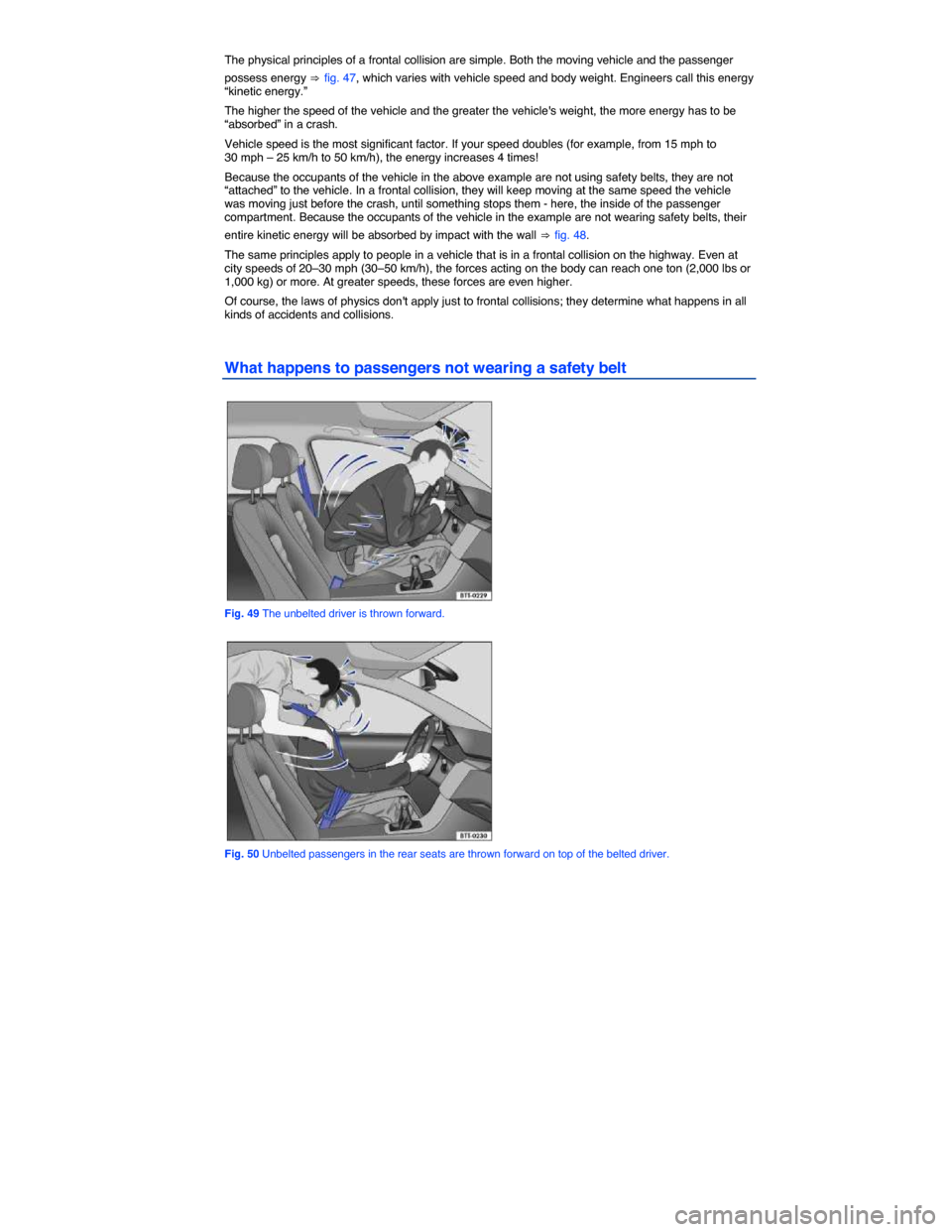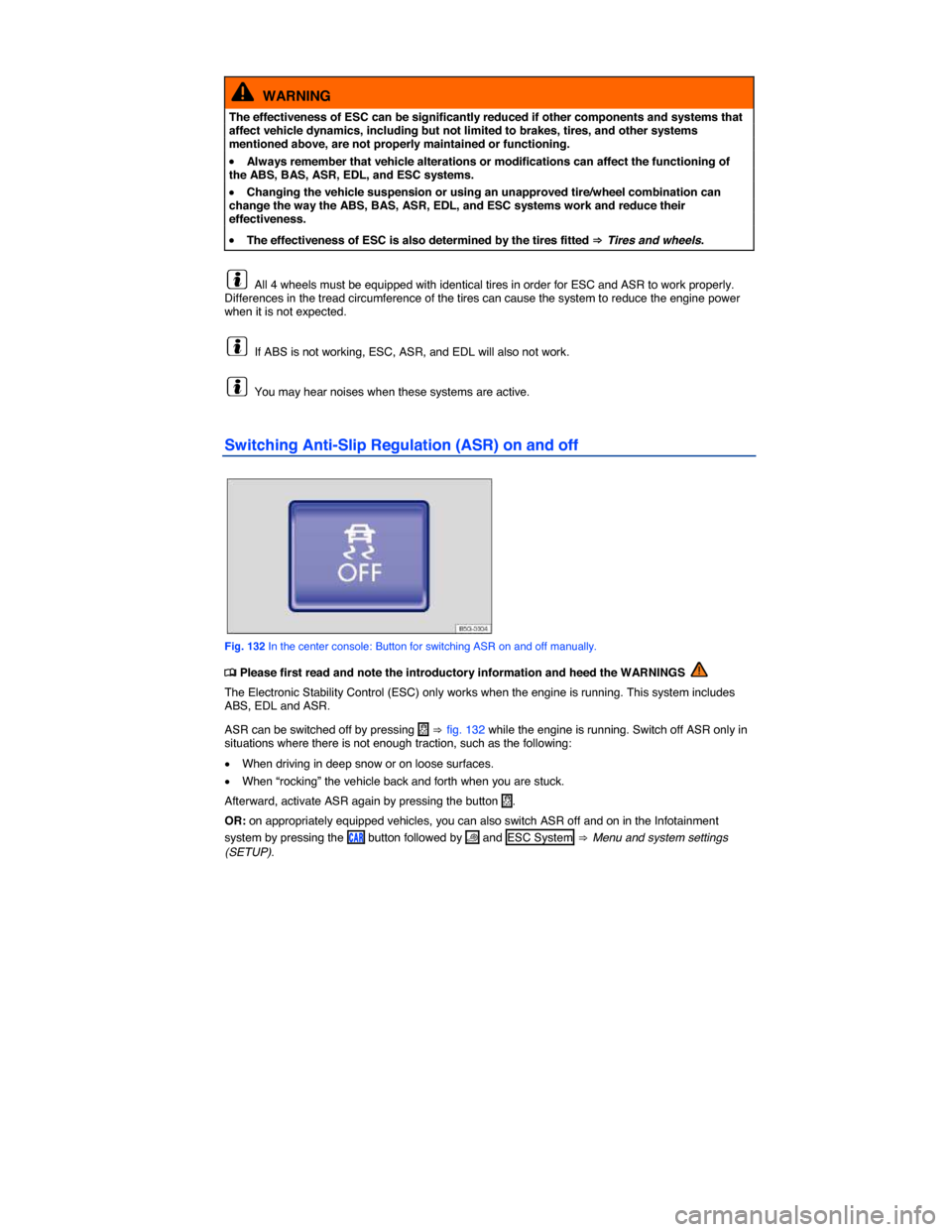ABS VOLKSWAGEN GOLF GTI 2015 5G / 7.G Owners Manual
[x] Cancel search | Manufacturer: VOLKSWAGEN, Model Year: 2015, Model line: GOLF GTI, Model: VOLKSWAGEN GOLF GTI 2015 5G / 7.GPages: 402, PDF Size: 6 MB
Page 95 of 402

The physical principles of a frontal collision are simple. Both the moving vehicle and the passenger
possess energy ⇒ fig. 47, which varies with vehicle speed and body weight. Engineers call this energy “kinetic energy.”
The higher the speed of the vehicle and the greater the vehicle's weight, the more energy has to be “absorbed” in a crash.
Vehicle speed is the most significant factor. If your speed doubles (for example, from 15 mph to 30 mph – 25 km/h to 50 km/h), the energy increases 4 times!
Because the occupants of the vehicle in the above example are not using safety belts, they are not “attached” to the vehicle. In a frontal collision, they will keep moving at the same speed the vehicle was moving just before the crash, until something stops them - here, the inside of the passenger compartment. Because the occupants of the vehicle in the example are not wearing safety belts, their
entire kinetic energy will be absorbed by impact with the wall ⇒ fig. 48.
The same principles apply to people in a vehicle that is in a frontal collision on the highway. Even at city speeds of 20–30 mph (30–50 km/h), the forces acting on the body can reach one ton (2,000 lbs or 1,000 kg) or more. At greater speeds, these forces are even higher.
Of course, the laws of physics don't apply just to frontal collisions; they determine what happens in all kinds of accidents and collisions.
What happens to passengers not wearing a safety belt
Fig. 49 The unbelted driver is thrown forward.
Fig. 50 Unbelted passengers in the rear seats are thrown forward on top of the belted driver.
Page 151 of 402

Do not use a bumper-mounted trailer hitch
Never install a trailer hitch on the bumper or on the bumper attachments. The trailer hitch must not interfere with the impact-absorbing bumper system. Do not make any changes to the vehicle exhaust and brake systems. From time to time, check that all trailer hitch mounting bolts are securely fastened. When you are not towing, remove the trailer hitch. This helps keep the trailer hitch from causing dam-age if your vehicle is hit from behind.
Engine cooling system
Towing a trailer makes the engine and its cooling system work harder. It is important that the engine cooling system is up to the job. Make sure that the cooling system has enough coolant.
Trailer brakes
If your trailer has its own brakes, make sure it meets all regulations. The trailer brake system must never be directly connected to the vehicle's brake system.
Safety chains
Always use safety chains between your vehicle and the trailer ⇒ Hitching up and connecting a trailer.
Trailer taillights
Trailer lights must meet all regulations ⇒ Hitching up and connecting a trailer.
Never connect the trailer lights directly to the electrical system of your vehicle.
Outside mirrors
If you cannot see the traffic behind you using the regular outside mirrors, then you must install extend-ed mirrors. Extended mirrors may also be required by law in some countries/states/provinces. Always adjust the outside mirrors before driving. It's vital that you always have a clear view to the rear of the vehicle.
Maximum power consumption for the trailer
Do not exceed the power ratings listed in the chart below.
Electrical load Maximum power
Brake lights total 108 watts
Turn signals per side 54 watts
Side marker lights total 100 watts
Taillights total 54 watts
WARNING
�x An improperly installed or incorrect trailer hitch can cause a trailer to separate from the tow vehicle and cause serious personal injuries.
�x If you don't have to tow a trailer any more, remove the entire trailer hitch. Always seal all bolt holes to prevent water and deadly exhaust fumes from getting into the vehicle.
Page 193 of 402

�x After any tire on your vehicle is removed and then remounted, even if the same tire and wheel rim that were taken off are reinstalled (for instance, after repair).
�x After any tire on your vehicle is changed and replaced by another tire, even if the replacement tire is the same type and is inflated to the same pressure as the tire it replaced.
�x After adjusting the tire pressure of any tire on the vehicle to its correct cold tire inflation pressure, either by putting air in one or more tires or by letting air out. Do this even though air was only added (or let out) to bring the tire to the inflation pressure it should have had all along.
�x After rotating the front and rear wheels ⇒ Tires and wheels.
�x After mounting the compact spare wheel.
WARNING
Incorrect recalibration can cause the TPMS to give false warnings or to give no warning despite dangerously low tire pressure. Make certain the tire inflation pressure of all tires is correct before recalibrating the system.
WARNING
Incorrect tire pressure can cause sudden tire failure, loss of vehicle control and serious personal injury.
�x Always check and correct air pressure in all 4 tires, particularly after changing, exchanging, or repairing tires.
�x After that, always make sure that all 4 tires are inflated to the correct tire pressure for the tires installed on the vehicle. Then recalibrate the system so that it can properly monitor the pressure in the tire.
�x See the tire pressure label ⇒ Tire inflation pressure and the Owner's Literature for recommended cold tire inflation pressure and other important information.
�x When replacing tires or wheel rims, always read and heed all of the information and
WARNINGS ⇒ Tires and wheels.
�x The Tire Pressure Monitoring System must be recalibrated whenever you remove and remount or change any wheel or tire on the vehicle, even if the reinstalled or replacement wheels and tires are identical to those that were removed and even if the tire pressure does not change.
The Tire Pressure Monitoring System stops working if there is an ESC/ABS malfunction
⇒ Braking and parking.
After a low tire pressure warning, the vehicle must stand and must not be driven for at least 1 minute before the new benchmark tire pressures can be stored.
Page 237 of 402

WARNING
Failure to heed warning lights and instrument cluster text messages can cause the vehicle to break down in traffic and result in a collision and serious personal injury.
�x Never ignore warning lights or text WARNINGS.
�x Always stop the vehicle as soon as it is safe to do so.
WARNING
Driving with bad brakes can cause a collision and serious personal injury.
�x If the brake warning light �"�2�!�+�% or �H does not go out, or lights up when driving, either the brake fluid level in the reservoir is too low or there is a fault in the brake system. Stop the
vehicle as soon as you can do so safely and get expert assistance ⇒ Brake fluid.
�x If the brake warning light �"�2�!�+�% or �H lights up at the same time as the ABS warning light �!�"�3 or �J, the ABS may not be working properly. This could cause the rear wheels to lock up relatively quickly during braking. Rear wheel brake lock-up can cause loss of vehicle control.
�x If you believe the vehicle is safe to drive, drive slowly and very carefully to the nearest authorized Volkswagen dealer, authorized Volkswagen Service Facility, or other qualified workshop and have the brake system inspected. Avoid sudden hard braking and steering.
�x If the ABS indicator light �!�"�3 or �J does not go out, or if it lights up while driving, the ABS system is not working properly. The vehicle can then be stopped only with the standard brakes (without ABS). You will not have the protection ABS provides. Contact your authorized Volkswagen dealer or an authorized Volkswagen Service Facility as soon as possible.
�x If the brake pads are worn or you notice changes in the way the vehicle brakes, immediately contact an authorized Volkswagen dealer or authorized Volkswagen Service Facility to have the brake pads checked and, if necessary, replaced.
NOTICE
Failure to heed warning lights or text WARNINGS can result in vehicle damage.
Parking brake
Fig. 131 Between the front seats: Parking brake.
�
Page 243 of 402

�x Push the brake pedal down hard and hold it there. Don't take your foot off the pedal or reduce the force on the pedal!
�x Do not “pump” the brake pedal or let up on it!
�x Steer the vehicle while pushing down hard on the brake pedal.
�x ABS stops working if you release or let up on the brake.
When ABS is doing its job, you will notice a slight vibration through the brake pedal and hear a noise. ABS cannot shorten the stopping distance under all conditions. The stopping distance may even be longer, for instance, when driving on gravel or on newly fallen snow covering an icy or slippery surface.
Brake Assist (BAS)
The Brake Assist System can help to reduce stopping distances. If you press the brake pedal very quickly, BAS detects an emergency situation. It then very quickly builds up full brake system pressure, maximizing braking power and reducing the stopping distance. This way, ABS can be activated more quickly and efficiently.
Do not reduce pressure on the brake pedal! BAS switches off automatically as soon as you release or let up on the brake.
Anti-Slip Regulation (ASR)
ASR reduces engine power directed to spinning wheels and adjusts power to the road conditions. Even under poor road conditions, ASR can make it easier to get moving, accelerate, and climb hills.
ASR can be switched on or off manually ⇒ Switching Anti-Slip Regulation (ASR) on and off.
Electronic Differential Lock (EDL and XDL)
EDL is applied during regular straight-line acceleration. EDL gently brakes a drive wheel that has lost traction (spinning) and redirects the drive force to other drive wheels. In extreme cases, EDL automatically switches off to keep the brake from overheating. As soon as the brake has cooled down, EDL automatically switches on again.
XDL is an extension of the Electronic Differential Lock system. XDL does not react to drive wheel slippage when driving straight ahead. Instead, XDL detects slippage of the inside front wheel during fast cornering. XDL applies enough brake pressure to this wheel in order to stop the slippage. This improves traction, which helps the vehicle stay on track.
WARNING
Driving fast on icy, slippery, or wet roads can lead to a loss of control and result in serious personal injury for you and your passengers.
�x Always adjust your speed and driving style to road, traffic, weather, and visibility conditions. Never let the additional safety that ESC, ABS, BAS, ASR, and EDL can provide tempt you into taking extra risks.
�x Braking assistance systems cannot overcome the laws of physics and always prevent loss of vehicle control. Slippery and wet roads are still dangerous even with ESC and the other systems!
�x Driving too fast on wet roads can cause the wheels to lose contact with the road and “hydroplane.” A vehicle that has lost road contact cannot be braked, steered, or controlled.
�x These systems cannot reduce the risk of accident, for example if you drive too fast for conditions or if you do not keep your distance from the vehicle in front of you.
�x Although these systems are very effective and can help you control the vehicle in many difficult situations, always remember that your vehicle handling control is limited by tire traction.
�x When accelerating on a slippery surface, for example on ice and snow, depress the accelerator carefully. Even with these systems, the wheels may start to spin, leading to a loss of vehicle control.
Page 244 of 402

WARNING
The effectiveness of ESC can be significantly reduced if other components and systems that affect vehicle dynamics, including but not limited to brakes, tires, and other systems mentioned above, are not properly maintained or functioning.
�x Always remember that vehicle alterations or modifications can affect the functioning of the ABS, BAS, ASR, EDL, and ESC systems.
�x Changing the vehicle suspension or using an unapproved tire/wheel combination can change the way the ABS, BAS, ASR, EDL, and ESC systems work and reduce their effectiveness.
�x The effectiveness of ESC is also determined by the tires fitted ⇒ Tires and wheels.
All 4 wheels must be equipped with identical tires in order for ESC and ASR to work properly. Differences in the tread circumference of the tires can cause the system to reduce the engine power when it is not expected.
If ABS is not working, ESC, ASR, and EDL will also not work.
You may hear noises when these systems are active.
Switching Anti-Slip Regulation (ASR) on and off
Fig. 132 In the center console: Button for switching ASR on and off manually.
�
Page 336 of 402

Type of stain Recommended cleaning for fabric and upholstery
Water-based stains, such as coffee or fruit juice. – Moisten a sponge with water and rub the stain gently with a circular motion. – Wipe dry with an absorbent cloth.
Persistent stains, such as chocolate or make-up. – Use only Volkswagen-approved cleaning products. – If necessary, have the fabric or upholstery professionally cleaned.
Grease-based stains, such as oil, lipstick, etc. – Use only Volkswagen-approved cleaning products. – If necessary, have the fabric or upholstery professionally cleaned.
WARNING
If there is a malfunction in the airbag system, the airbag may not deploy correctly or at all, or it may deploy unexpectedly. This could cause fatal injuries.
�x Have the airbag system inspected immediately by your authorized Volkswagen dealer or authorized Volkswagen Service Facility.
NOTICE
If the upholstery on power seats, heated seats, or seats with airbag components is wet, electrical components and the vehicle electrical system could be damaged.
�x If the seating surface becomes soaked, have it dried and the system components checked immediately by an authorized Volkswagen dealer or authorized Volkswagen Service Facility.
�x Do not use steam cleaners because the steam could cause the dirt to penetrate deeper into the fabric and make it impossible to remove.
�x Power washers and cooling sprays can damage the upholstery.
NOTICE
�x Clean only the carpet and floor mats with brushes. Other textile surfaces can be damaged by brushes.
�x If detergent pastes or mild detergent solutions are applied with a damp cloth or sponge, the surfactants in the detergent may cause visible lines to form at the edges of the area where the detergent was applied. These lines are generally difficult or impossible to remove.
NOTICE
�x Do not soak Alcantara®.
�x Do not treat Alcantara® with leather care products, solvents, floor wax, shoe polish, stain remover or similar products.
�x Do not use brushes for damp cleaning, because they can damage upholstery surfaces.
�x Do not use a steam cleaner, because dirt will penetrate deeper into the fabric.
Page 338 of 402

Type of stain Cleaning
Grease-based stains, such as oil, lipstick, etc. – Remove fresh stains with an absorbent cloth. – Use an appropriate cleaning agent on stains that have not yet
penetrated the surface ⇒ .
Special stains, such as ballpoint pen, marker, nail polish, latex paint, or shoe polish.
– Dab dry with an absorbent cloth. – Clean with a special stain remover designed for leather.
NOTICE
�x Stains that have been left in place too long will penetrate the surface of the leather and cannot be removed.
�x Never treat leather with solvents, floor wax, shoe polish, stain remover or similar products.
�x Wipe up spilled liquids immediately with an absorbent cloth. Liquid can penetrate leather surfaces and seams within a few seconds.
�x If the vehicle is left in the sun for a long time, cover the upholstery to protect the leather from direct sunlight and to help prevent fading and discoloration.
Slight discoloration caused by wear and tear is normal.
Cleaning leatherette
�
Page 345 of 402

Changing the vehicle's suspension system can change the way that the airbag system works in a crash. For example, using tire-rim combinations not approved by Volkswagen, lowering the vehicle, changing the stiffness of the suspension, including the springs, suspension struts, shock absorbers etc. can change the forces that are measured by the airbag sensors and sent to the electronic control unit. Some suspension changes can, for example, increase the force levels measured by the airbag sensors and sent to the electronic control unit and make the airbag system deploy in crashes in which it would not deploy if the changes had not been made. Other kinds of changes may reduce the force levels measured by the sensors and prevent the airbag from deploying when it should.
Never install leather upholstery on a vehicle that originally had cloth upholstery. Never install cloth upholstery on a vehicle that originally had leather upholstery. The capacitive passenger detection system for the Advanced Airbag system will not work properly if different upholstery is installed on the passenger seat than the upholstery originally installed on the vehicle when it was originally manufactured.
WARNING
Changing the vehicle's suspension including use of unapproved tire-rim combinations can change airbag performance and increase the risk of serious personal injury in a crash.
�x Never install suspension components that do not have the same performance characteristics as the components originally installed on your vehicle.
�x Never use tire-rim combinations that have not been approved by Volkswagen.
WARNING
Leaving the optional safety belt extender attached to the safety belt buckle on the front passenger seat when the safety belt is not being used will prevent the Advanced Airbag System from working properly and can increase the risk of serious personal injury in a collision.
�x Leaving the extender attached to the safety belt buckle when the front seat is occupied and the safety belt is not being used will signal to the airbag control unit that the front passenger seat is occupied and that the safety belt is being used. The electronic control unit for the airbag system will then receive incorrect information that will
– cause the safety belt pretensioner to deploy unnecessarily in collisions and
– cause the front passenger airbag to deploy later in collisions in which the front airbag would otherwise be triggered earlier to help protect an unrestrained front seat passenger.
�x Always remove the safety belt extender when it is not needed and stow it safely.
�x Never use the safety belt extender to secure a child restraint.
WARNING
Items stored between the safety belt buckle and the center console can cause safety belt buckle to send the wrong information to the airbag control unit and prevent the Advanced Airbag System from working properly.
�x Always make sure that nothing can interfere with the safety belt buckles and that they are not obstructed.
Page 401 of 402

Abbreviations
Abbreviation Meaning
6S auto 6-speed automatic transmission
6S man 6-speed manual transmission
ABS Anti-lock Brake System
AFS Adaptive Front Lighting System
AKI Anti-Knock Index
ANSI American National Standards Institute
ASR Anti-Slip Regulation
ATA Anti-Theft Alarm system
BAS Brake Assist System
ccm Cubic centimeter – metric unit of measure for engine displacement
CCS Cruise Control System
CID Cubic inch displacement – unit of measure for engine displacement
cm Centimeter – metric unit of measure for length
CO2 Carbon dioxide
DIN Deutsches Institut für Normung (German Institute for Standardization)
DRL Daytime Running Lights
DSG® DSG automated transmission
EDL Electronic Differential Lock
EN European Norm
EPC Engine control (Electronic Power Control)
ESC Electronic Stability Control
g/km Generated carbon monoxide amount in grams per kilometer driven
GAWR Gross Axle Weight Rating
GVWR Gross Vehicle Weight Rating
HID High Intensity Discharge headlights (Xenon)
hp Horsepower – unit of measure for engine power
kg Kilogram – metric unit of measure for weight
kN Kilonewton – a unit of measure for force
kp Kilopond – unit of measure for force
kPa Kilopascal – unit of measure for tire pressure
kW Kilowatt – engine rating
LED Light Emitting Diode
m Meter – metric unit of measure for length
MDI Media Device Interface (MEDIA-IN)